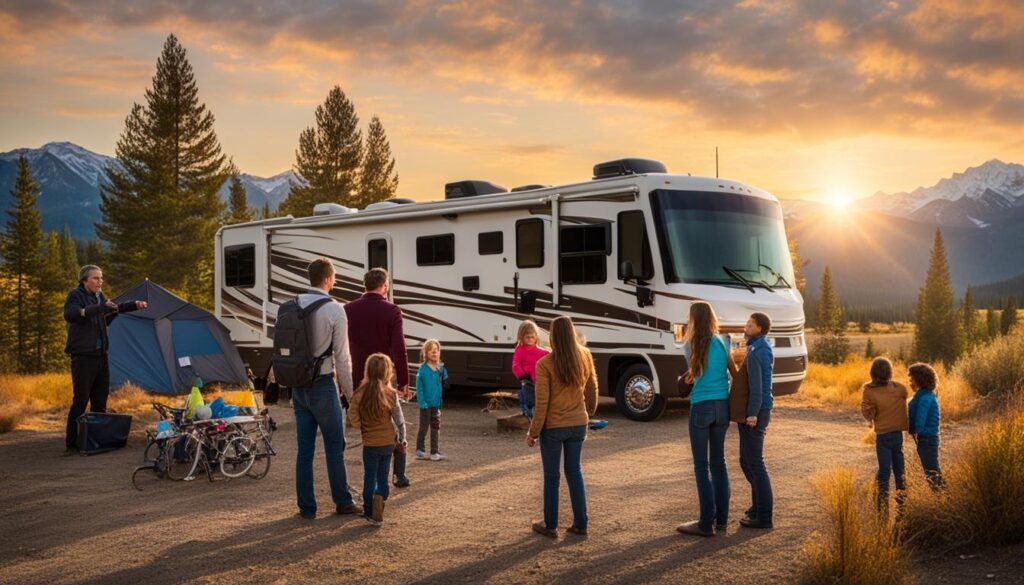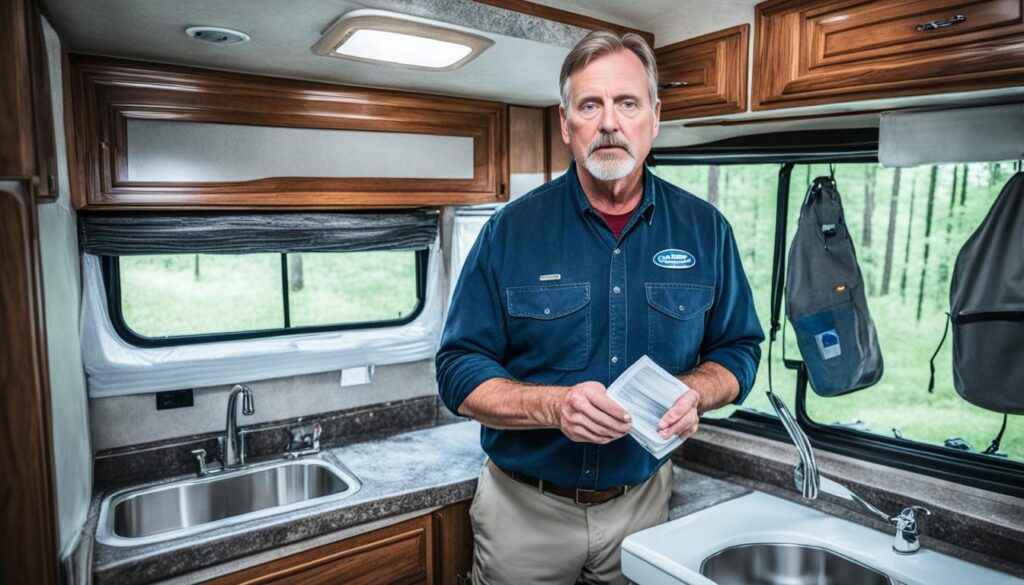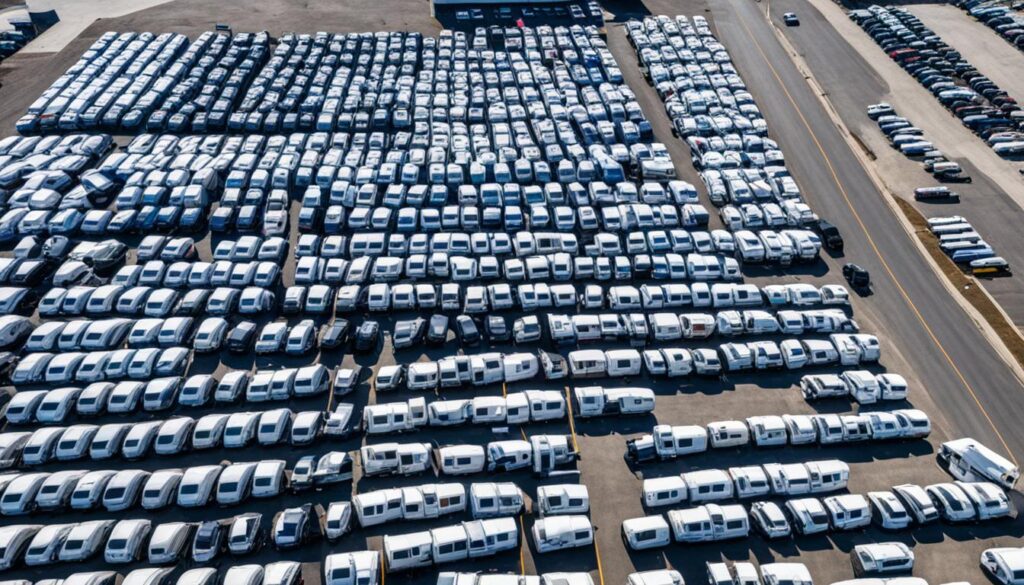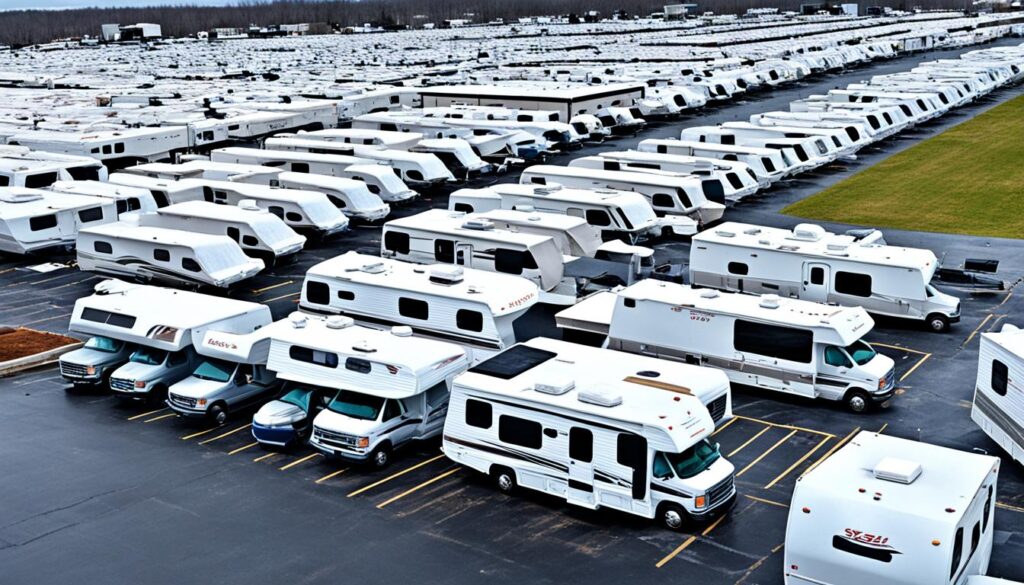Are you considering buying a used RV? It’s a great way to hit the road and embark on new adventures without breaking the bank. But before you make a purchase, do you know what to look for? The last thing you want is to end up with a money pit on wheels.
Take a moment to imagine yourself cruising down the open highway, the wind in your hair, and the freedom of the open road ahead. Now, ask yourself: Are you ready to make the right decision when it comes to buying a used RV? Are you prepared to ensure every dollar you spend is worth it?
Don’t worry! I’m here to guide you through the process. In this article, I’ll share the top things you need to look for when buying a used RV. From hiring a third-party inspector to checking the VIN, assessing the age of the tires, and inspecting for moldy smells and water damage, I’ve got you covered. We’ll explore everything you need to know to make a confident and informed decision.
Key Takeaways:
- Hire a certified third-party inspector to evaluate the condition of the used RV.
- Check the Vehicle Identification Number (VIN) to verify the RV’s history and ensure it matches the seller’s description.
- Inspect for any signs of moldy smells or water damage.
- Assess the age and condition of the tires, considering their potential maintenance or replacement costs.
- Examine the wallpaper for bubbling, as it may be an indication of past or current water damage.
Contents
Hire a 3rd Party Inspector
When it comes to buying a used RV, it’s crucial to get an expert opinion before making a purchase. That’s why I highly recommend hiring a certified third-party inspector to thoroughly assess the condition of the RV. A professional inspector can uncover any hidden issues that the seller may not disclose, giving you peace of mind and potentially saving you from future costly repairs.
Whether you’re buying from a private seller or a dealership, a third-party inspection is essential for ensuring that you’re getting a reliable and safe RV. These inspectors specialize in RV inspections and have the knowledge and experience to identify any potential problems.
So, where can you find a certified RV inspector near you? A quick search for “RV inspector near me” should yield some results. You can also check the National RV Inspectors Association of America website, which provides a directory of certified inspectors across the country.

Having a third-party inspector on your side during the buying process can give you the confidence to negotiate a fair price and make an informed decision. They can provide you with a comprehensive report detailing the RV’s condition, highlighting any areas of concern, and giving you a clearer picture of what you’re buying.
Remember, when it comes to buying a used RV, an ounce of prevention is worth a pound of cure. Investing in a third-party inspection can save you from costly surprises down the road and ensure you’re getting a quality vehicle.
Check the VIN
When purchasing a used RV, it is crucial to verify the vehicle identification number (VIN). The VIN provides essential information about the RV’s identity, history, and condition. By checking the VIN, you can ensure that the RV has not been involved in any previous accidents, recalls, or major repairs.
One of the primary benefits of checking the VIN is confirming the accuracy of the seller’s description. It enables you to verify the age of the RV, which can impact its value and potential maintenance needs. Additionally, the VIN check can reveal valuable insights into the RV’s overall condition, giving you a clearer picture of what you’re about to purchase.
Look for the VIN on the RV’s dashboard or driver’s side door jamb. It is typically a 17-digit code consisting of both numbers and letters. Once you have the VIN, you can use various online tools or resources to conduct a VIN check. These tools can provide you with an in-depth history report, uncovering important details that the seller may not disclose.
When performing a VIN check, pay attention to the following:
- Accident history: A VIN check can reveal if the RV has been involved in any accidents. This information is crucial for assessing the structural integrity of the vehicle and potential hidden damage.
- Recalls: Check if there are any open recalls for the RV. Recalls address safety-related defects and must be repaired by the manufacturer free of charge. Knowing about recalls can help you avoid purchasing an RV with unresolved issues.
- Service records: Some VIN check reports may provide service records, which can give you an idea of how well the RV has been maintained throughout its life. Regular maintenance is essential for the longevity and reliability of the RV.
- Seller’s honesty: If the VIN check report reveals discrepancies or missing information, it can indicate that the seller is not fully transparent. This may be a red flag for potential hidden issues or dishonesty regarding the condition of the RV.
By checking the VIN and reviewing the provided history report, you can make a more informed decision when buying a used RV. It adds an extra layer of protection and ensures that you are investing in a reliable and well-documented vehicle.
Remember, don’t solely rely on the seller’s claims. Conduct your due diligence and use the VIN check as a valuable tool in your buying process.
| Benefits of Checking the VIN | Considerations |
|---|---|
| Verifies RV identity and history | Perform a thorough VIN check using reliable online tools |
| Confirms age of the RV | Look for the VIN on the dashboard or driver’s side door jamb |
| Reveals previous accidents, recalls, or repairs | Watch out for discrepancies or missing information that may indicate dishonesty |
| Provides valuable insights into the RV’s overall condition | Consider the VIN check report alongside other inspection findings |
Inspect for Moldy Smell and Water Damage
When buying a used motorhome, it’s crucial to be attentive to any signs of moldy smell, as it could indicate water damage and potential issues with the vehicle. Mold can be a result of leaks or excess moisture, which can lead to structural damage and costly repairs if not addressed promptly.
To identify the presence of mold, carefully inspect the interior of the RV for visible signs such as bubbling wallpaper, discolored surfaces, or musty odors. These indications can serve as red flags for underlying water damage.
If you notice any suspicious areas, consider hiring a professional inspector who can assess the extent of the damage and provide an expert opinion on the necessary repairs. They can also uncover hidden mold that may not be immediately visible to the untrained eye.
“Water damage can cause serious issues in a motorhome, including compromised structural integrity and health hazards from mold. It’s crucial to thoroughly inspect the vehicle to avoid costly repairs and ensure a safe and enjoyable RVing experience.”
Remember, prevention is key when it comes to water damage. Taking swift action at the first signs of mold or water intrusion can help mitigate further damage and save you from significant expenses down the road. So, before making a purchase, be thorough in your inspection and consider enlisting the help of a professional to ensure you’re making a wise investment.

Common areas prone to water damage and mold growth in an RV:
- Bathroom and shower areas
- Kitchen sink and plumbing connections
- Roof seams and vents
- Window frames and seals
- Under sinks and around plumbing fixtures
By paying close attention to these areas during your inspection, you’ll be better equipped to identify any potential water damage issues and make an informed decision when buying a used RV.
Assess the Age of the Tires
When buying a used RV, it’s crucial to assess the age and condition of the tires. The tires play a vital role in the safety and performance of the RV, so it’s essential to ensure they are in good shape.
To determine the age of the tires, look for the DOT code on the sidewall. This code indicates the manufacture date of the tire. It usually consists of four numbers, with the first two representing the week and the last two indicating the year of manufacture.
It’s recommended to replace tires every 3-5 years, regardless of their tread depth. Over time, tires can degrade due to exposure to UV light and environmental factors. Even if the tread looks sufficient, the tires may still be compromised and pose a safety risk.
If the tires on the used RV are old or show signs of wear, consider negotiating the price with the seller to account for the cost of replacing them. Alternatively, you can have the tires replaced before embarking on your RV adventures to ensure optimal safety.

| Age of Tires | Recommended Action |
|---|---|
| Less than 3 years | No immediate action required. Regular maintenance and inspection recommended. |
| 3-5 years | Consider replacing the tires if signs of wear or deterioration are present. |
| Over 5 years | Strongly consider replacing the tires to ensure maximum safety and reliability. |
Ensuring the tires of the used RV are in good condition is essential for a smooth and safe journey. By paying attention to the age and wear of the tires, you can make an informed decision and enjoy your RV adventures with peace of mind.
Examine the Wallpaper for Bubbling
Bubbling wallpaper is a potential sign of moisture damage in an RV. It can be caused by leaks in the roof, walls, or faulty plumbing. Ask the seller about the cause of the bubbling wallpaper and assess if the problem has been resolved. Keep in mind that some sellers may not be aware of the extent of water damage, so it’s essential to have a professional inspector assess the situation.
Insider Tip:
If you notice bubbling wallpaper in the RV, don’t ignore it. It could be a sign of significant water damage that may require extensive repairs. An experienced inspector can evaluate the extent of the damage and provide you with an informed assessment of the repair costs.
Review the Roof and Slide-Outs
When buying a used RV, it is crucial to thoroughly inspect the roof and slide-outs for any signs of damage or potential issues. These areas are susceptible to wear and tear and can greatly impact the overall condition of the vehicle.
Inspecting the Roof
The roof of the RV is exposed to various weather conditions and needs to be in good condition to prevent leaks and water damage. Here are some steps to follow when inspecting the roof:
- Use a flashlight and binoculars to get a closer look at the roof, especially hard-to-reach areas.
- Check for any cracks, tears, or missing seals on the roof surface.
- Look for signs of water damage, such as discoloration or sagging areas.
- Inspect the roof vents and air conditioning unit for proper sealing and functioning.
Keep in mind that repairing or replacing an RV roof can be costly, so it is essential to identify any potential issues before making a purchase. Consider hiring a professional inspector to thoroughly assess the roof’s condition.
Examining the Slide-Outs
Slide-outs can significantly enhance the living space in an RV, but they require regular maintenance and careful inspection. Here’s what to look for when examining the slide-outs:
- Check the slide-out mechanism for smooth operation. Ensure that it extends and retracts without any issues.
- Inspect the slide-out seals for signs of wear or damage. Damaged seals can lead to leaks and water damage inside the RV.
- Look for any structural damage, such as cracks or warping, on the slide-out components.
- Test the latch and locking system to ensure it functions properly and securely holds the slide-out in place.
Proper maintenance and regular inspections can help prevent costly repairs and ensure the longevity of the slide-outs.
| Roof Inspection Checklist | Slide-Out Inspection Checklist |
|---|---|
| Check for cracks and tears on the roof surface. | Ensure smooth operation of the slide-out mechanism. |
| Look for signs of water damage, such as discoloration or sagging areas. | Inspect slide-out seals for wear and damage. |
| Inspect roof vents and air conditioning unit for proper sealing. | Check for structural damage on the slide-out components. |
Check Systems and Seals
When buying a used RV, it is crucial to thoroughly test all the systems to ensure they are in proper working order. Take the time to check the toilet, shower, refrigerator, air conditioner, heater, and safety systems such as the fire alarm and carbon monoxide detector. Make sure that each of these systems functions as it should and meets your expectations for comfort and safety.
In addition to the internal systems, it is equally important to assess the condition of the seals and caulking in the RV. These seals help protect against water and air leaks, which can cause significant damage and compromise the structural integrity of the vehicle. Inspect the seals for any signs of wear or damage and prioritize necessary repairs to prevent future issues.
It is also essential to evaluate the extent of any problems found during the inspection process. Consider the potential repair costs and whether they fit within your budget. It’s helpful to consult with a trusted used RV dealer who can provide guidance and advice based on their experience.
By thoroughly checking the systems and seals in a used RV, you can ensure a smooth and enjoyable travel experience. Take the time to inspect these crucial components, and if any issues arise, address them before finalizing your purchase.
FAQ
Why is it recommended to hire a certified third-party inspector when buying a used RV?
Hiring a certified third-party inspector is important because they can verify the condition of the RV and uncover any hidden issues that the seller may not disclose. This is especially crucial when buying from a private seller. It is advised to search for “RV inspector near me” or check the National RV Inspectors Association of America to find a certified inspector.
Why is it important to check the vehicle identification number (VIN) of a used RV?
Checking the VIN of a used RV is crucial as it can confirm the identity and history of the RV, including any previous accidents, recalls, or repairs. It can also help determine the age of the RV and its value. Look for the VIN and use online tools or resources to check its history and ensure it matches the seller’s description.
What should I look for to assess potential moldy smell and water damage in a used RV?
When inspecting a used RV, be cautious of any moldy smell as it could indicate water damage and potential issues. Check for visible signs of mold, such as bubbling wallpaper or musty odors. Mold can be a result of leaks or excess moisture, so it’s important to identify the source and assess the necessary repairs. A professional inspector can help identify hidden mold and water damage.
How can I assess the age and condition of the tires on a used RV?
It’s essential to check the age and condition of the tires on a used RV. Look for the DOT code on the tires’ sidewall, which indicates the manufacture date. Tires should be replaced every 3-5 years, regardless of their tread depth, as they can degrade over time due to exposure to UV light and environmental factors. Consider negotiating or replacing the tires if they are old or show signs of wear.
What does bubbling wallpaper indicate in a used RV?
Bubbling wallpaper is a potential sign of moisture damage in an RV. It can be caused by leaks in the roof, walls, or faulty plumbing. Ask the seller about the cause of the bubbling wallpaper and assess if the problem has been resolved. Keep in mind that some sellers may not be aware of the extent of water damage, so it’s essential to have a professional inspector assess the situation.
What should I consider when reviewing the roof and slide-outs of a used RV?
When inspecting a used RV, carefully examine the roof for any cracks, missing seals, signs of water damage, or UV damage. Use a flashlight and binoculars to get a closer look at hard-to-reach areas. Additionally, check the slide-outs for smooth operation, leaks, structural damage, and latch issues. Slide-outs can greatly enhance the living space in an RV, but they require proper maintenance to avoid potential problems.
What systems should I test in a used RV before purchasing?
Before making a decision, it’s important to test all the systems in the used RV, including the toilet, shower, refrigerator, air conditioner, heater, and safety systems such as fire alarm and carbon monoxide detector. Ensure they are functioning properly. Check the caulking and seals for signs of wear or damage, as these protect against water and air leaks. Evaluate the extent of any problems found and consider potential repair costs.






